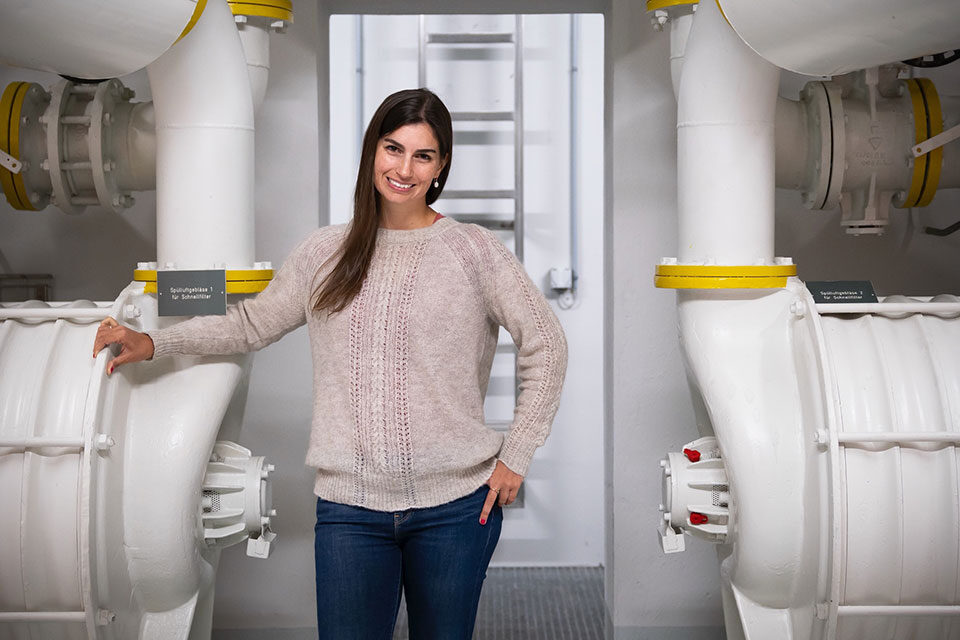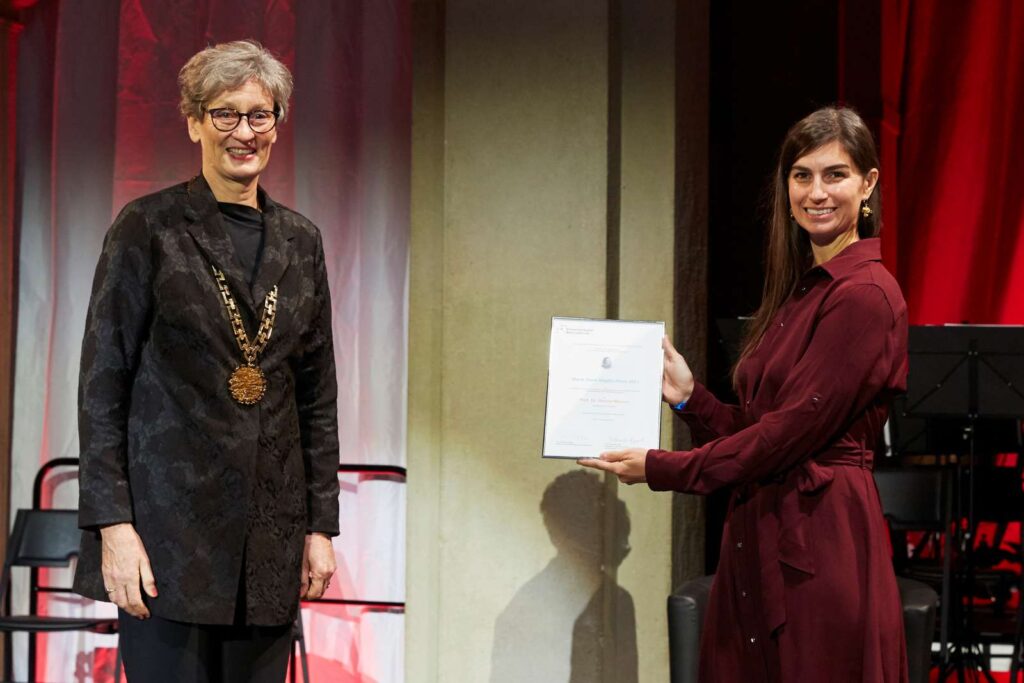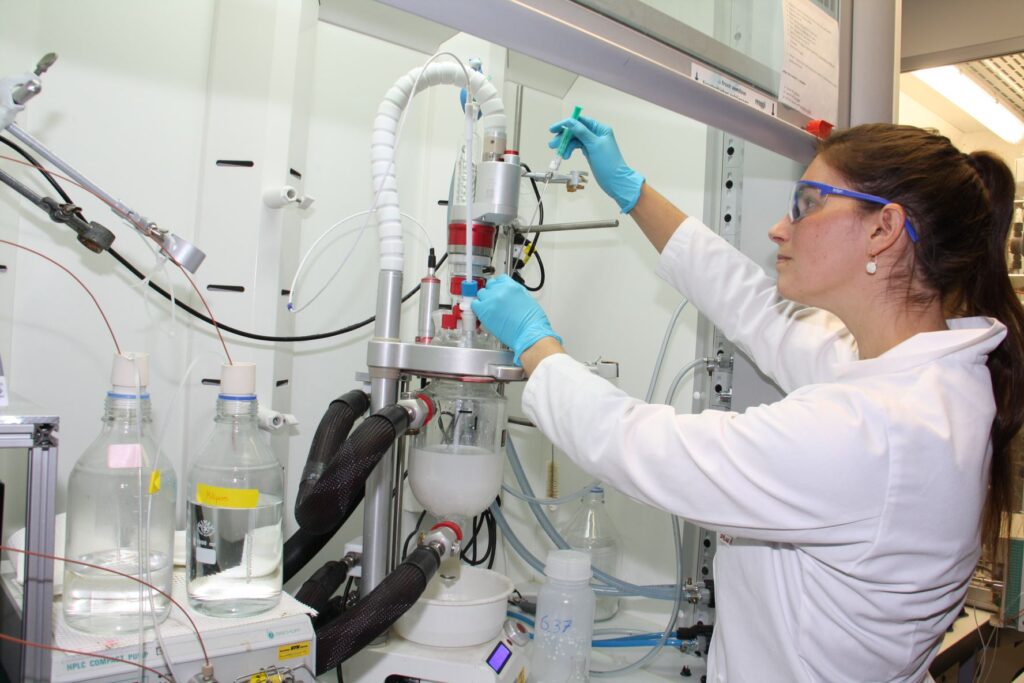Dr. Denise Mitrano ’08 conducts groundbreaking research to track micro- and nanoplastics

2022 has been a good year for Dr. Denise Mitrano ’08. A geochemist and assistant professor at ETH Zurich in the environmental systems science department, she is the recipient of the James J. Morgan Early Career Award for Outstanding Contributions to Environmental Science from ES&T and the ACS Division of Environmental Chemistry, as well as the Emerging Leader in Atomic Spectroscopy Award by “Spectroscopy.”
Mitrano has been named to the list of 100 most influential people for “Who’s Who in Zurich,” and she’s also been awarded the 2022 Marie Heim-Vögtlin Prize for Outstanding Young Woman Researcher of the Year from the Swiss National Science Foundation (SNSF) – which recognizes an outstanding woman researcher who is an inspiring role model, has achieved impressive results during her funding period and has made major advances in her career.
Her research assesses the impacts of anthropogenic activities and particles on the natural environment. Most recently, Mitrano’s research team has been focusing on how manmade plastic pollutes the environment. As mismanaged plastic waste breaks down into micro- and nanoparticles, it poses an increasing problem – not only for the oceans and their inhabitants, but also for lakes, rivers and soils.
For a long time, it was difficult to quantify and track these particles in natural systems, which are as small as a few millionths of a millimeter in size. Mitrano has found a way to track how these particles spread through the environment and has developed a method to track micro- and nanoplastics in water, soil and even organisms.
“As a researcher, I have developed a certain set of tools and techniques which I can then apply to a diverse set of problems, but with certain foci,” she said. “In my case, this is measuring metals in the environment, measuring particles and understanding how particles move through the water, through the soil or are taken up by biological organisms. I try to see where there are research gaps in a particular field where I may be able to use my expertise to answer questions no one else would be able to. I also like to understand how human activity is impacting the environment – and if there is a way we can make materials, use resources or have better practices to minimize negative environmental consequences.”
In this context, Mitrano’s research group uses results to assess risks of anthropogenic materials, which are caused or produced by humans, across various ecosystems and scales. An interest in a “safer by design” approach for both engineered nanomaterials and plastics is exemplified by working on the boundaries of environmental science, materials science and policy to promote sustainability and environmental health and safety of new materials.
The 13th winner of the MHV Prize, Mitrano sees the award as valuable recognition of her work to date and as motivation to continue in the same vein. She also wants to promote young female researchers within her own research group, which she has been leading since 2020 as an assistant professor with a SNSF Eccellenza Fellowship.
“I know from my own experience how inspiring female role models can be, so I’m now all the more happy to become a role model myself,” she said. “I want to encourage young women to be confident in pursuing their own ideas and not to be too put off by criticism and failure. It takes courage, but it’s worth it.”

Dr. Denise Mitrano (right) is awarded the SNSF Marie Heim Vögtlin Prize at ETH Day by Sarah Springman.
Plastic on the move − in water, soil and plants
Originally, Mitrano was not interested in plastics but in engineered metal nanoparticles, such as those found in textiles and cosmetics, as well as how natural metal nanoparticles behave in the environment. Her breakthrough idea was to transfer the analytical methods used to measure such nano-sized metals to plastic particles; she developed a process for chemically adding metals to plastic particles. The advantage of this is that metals can be measured with much more sensitive methods than plastics – and also much faster.
As an example of the utility of these materials to study the fate and transport of plastics in a replica of a small-scale sewage treatment plant, Mitrano investigated what happens to plastic particles and was able to show that the plant removes over 95% of the micro- and nanoplastics from the water, accumulating them in the sewage sludge.
“But that doesn’t solve the problem of plastic pollution entirely,” she said. “In many countries, sewage sludge is used as fertilizer for agricultural soils, which means that the plastic particles end up back in the environment.”
In further experiments, Mitrano investigated what happens to microplastics in soils and plants. Among other things, she discovered that the particles are taken up by plants and trigger a stress reaction in them.
“The more we know about the pathways of plastic particles and their harmful effects, the better we can prevent plastic from entering the environment in the future,” she said.
Mitrano is involved at the interface of science and policy and recently published an assessment of new definitions and regulations on microplastics from the European Chemicals Agency ECHA. She also believes in the value of collaboration in research. Following her recognition for the Emerging Leader in Environmental Science Award, Mitrano shared her thoughts on how her work impacts other scientists.
“The thing I like most about being an analytical chemist is that other researchers are able to use our methods and take them even further to better investigate their own research objectives,” she said. “It is both exciting and humbling for my work to be recognized … and to have my name be listed amongst the other excellent up-and-coming researchers in the field of environmental sciences. I am very passionate about the work that we do in my lab, but also inspired by the amazing students who work alongside me and thankful for my mentors and colleagues who have helped shape my career and outlook to date.”
Studying science within the context of liberal arts
As a chemistry major at Salve Regina, Mitrano learned about structure and problem-solving from Dr. Susan Meschwitz, associate professor and chair of the Department of Chemistry. The skills she acquired in Salve Regina’s labs continue to help her in her research today.
“One reason I chose Salve was that the class sizes were very small and close-knit and therefore the professors were also very available to give all students individual attention and help personalize not only the course material but career and life advice,” Mitrano said. “I particularly have appreciated the variety of coursework a liberal arts education provided, which helped shape my understanding and worldview in addition to understanding basic scientific information in my core subject areas.”
Mitrano also credits Dr. Jameson Chace, professor in the Department of Biology and Biomedical Sciences, as another positive influence on her early career. With his assistance, she secured a summer research position at the Rocky Mountain Biological Laboratory, located in the abandoned mining town of Gothic, Colorado.
“This was my first time working with many different research scientists and developing my own research questions,” she said. “I fell in love with Colorado and so it also prompted me to look for Ph.D. positions there. I eventually enrolled in the chemistry and geochemistry department at Colorado School of Mines.”
Throughout her doctoral studies, Mitrano discovered a passion for cutting-edge research and sharing her work around the world at conferences and universities. As she began to consider postdoctoral research, she decided to focus solely on opportunities in Europe, which would enable her to learn about other cultures and ways of life.
“I got quite lucky in the fact that I was presenting my research at a conference and a professor from Switzerland found my work interesting and offered me a job on the spot,” said Mitrano, who has lived abroad for the past nine years. “Even though I had never been to Switzerland before, I love living in the mountains. I knew I could be quite well connected to other parts of Europe for travel – either personal or professional. So I accepted, and I haven’t regretted it for one minute!”
Thinking outside the box
Looking ahead, Mitrano hopes to continue to bridge academic science with other stakeholders from policy, industry and the public to make scientifically informed decisions about the materials everyone uses and how this impacts the natural environment.
“On a day-to-day basis, to me, science is about problem solving and the excitement when you have finally accomplished a difficult puzzle (sometimes after much trial and error!),” she said. “But the implications of our work go beyond the laboratory. Understanding how human activities influence physical, chemical and biological cycles is a central component of modern geosciences, and I find it very rewarding to contribute knowledge that can lead toward the protection of our waterways and soils.”
In considering advice to share with students, and young women in particular, who are just beginning their studies at Salve Regina, Mitrano suggests exploring many different areas of research until they find one that “clicks.”
“Be brave and think outside the box. As a young scientist, you have the opportunity to focus on a new field and develop innovative methods that are not yet established,” Mitrano advised. “This may entail risks, but in the best-case scenario, you can become a pioneer in your own field. Perhaps the two things that have helped my professional success the most are to keep an open mind and to ask many questions.”
Article written by Mary Edwards ’86, ’12 (M). Editor’s note: This article was published in Report from Newport’s spring 2021 edition. Parts of this article have been edited from their original form.


